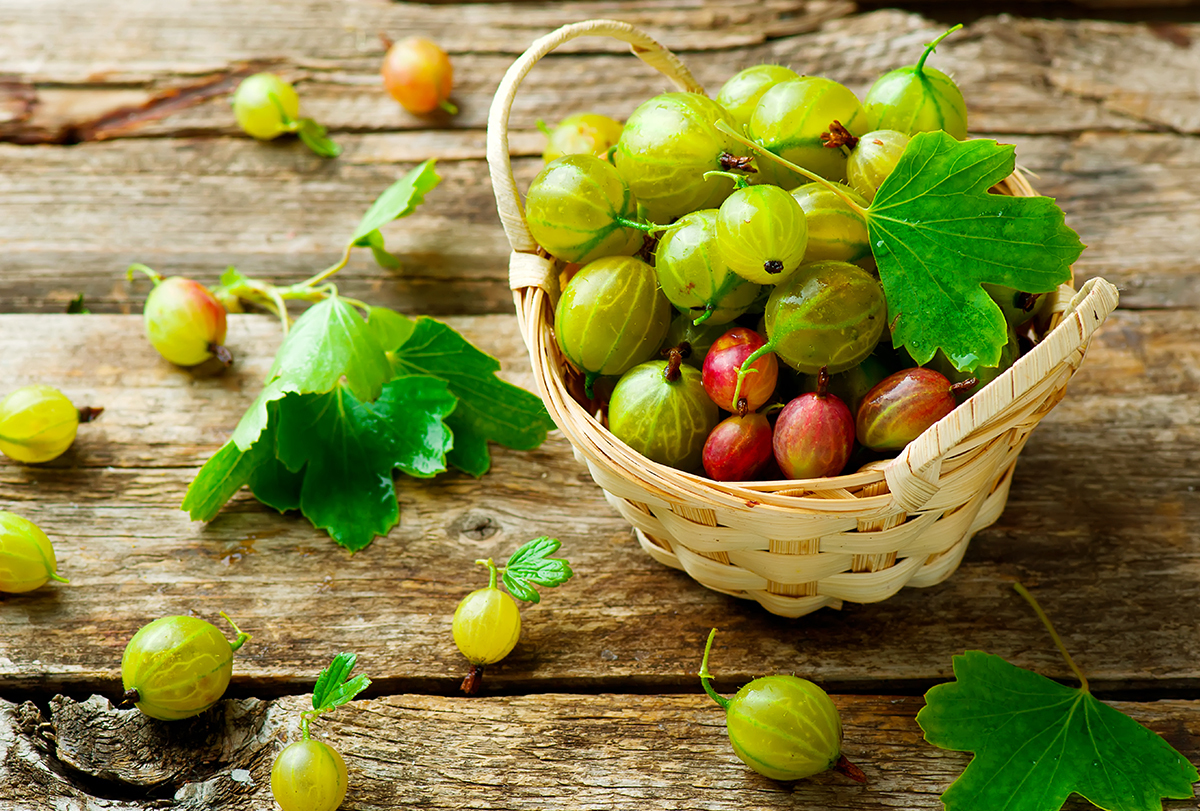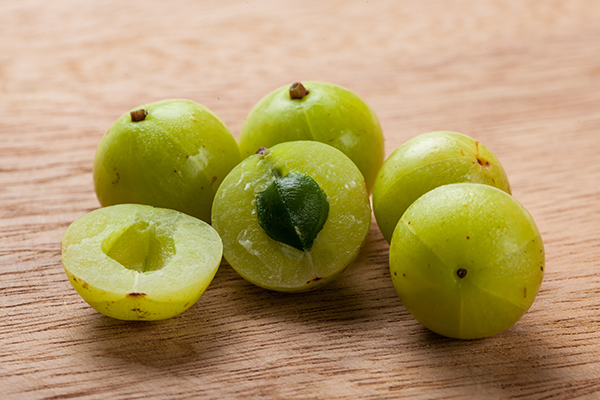In this article:
Amla is a very common ingredient that is used in a number of Ayurvedic preparations.

Also known as Indian gooseberry and emblic myrobalan, Amla is a vibrant-green-colored fruit with a strong sour, acidic, and bitter (astringent) taste. The amla tree can be found in India, the Middle East, and several other Southeast Asian nations.
Owing to its powerful antioxidant properties, this ingredient is extensively used in Ayurvedic medicines and natural remedies. It can help boost the health of your skin and hair as well as strengthen your immune system.
Merits of Amla (Indian Gooseberry)
Here are 10 health benefits of amla.
1. Promotes hair growth
In Ayurvedic medicine, amla is used as a remedy for various hair problems, such as premature graying, dull hair, and hair loss.
A deficiency of several nutrients has been linked to hair loss. (1) Amla’s effectiveness in treating hair problems may be due to its iron and nutrient content.
How to use:
Eat an amla fruit daily or use amla oil to massage your scalp a few times each week for healthy and gorgeous hair.
2. Improves eyesight
Amla is effective in improving your eyesight. The vitamin C and other antioxidants present in this ingredient promote healthy capillaries and help maintain proper functioning of the retinal cells. This is important for a healthy vision. It may also help to reduce reddening, itching, and watering of the eyes. (2)
In addition, vitamin A and carotene in amla help reduce the risk of macular degeneration in older people (3) and also play a role in preventing night blindness. It is especially effective in reversing night blindness caused by vitamin A deficiency. (4)
How to use:
- Mix 2 teaspoons of amla juice in ½ cup of water. You may also add some honey. Drink this mixture every morning to promote eye health.
- You can also consume a sweetened preserve known as “amla murabba.”
3. Aids in diabetes management
Amla is rich in chromium, which helps regulate carbohydrate metabolism and remediates insulin sensitivity. (5) This, in turn, helps the body regulate blood glucose levels.
According to a study published in the 2005 edition of the Journal of Medicinal Food, amla improves glucose metabolism in people suffering from diabetes. (6)
How to use:
Mix 1 or 2 teaspoons of amla powder or juice in 1 glass of water. Drink this juice daily on an empty stomach to control diabetes and manage the complications associated with it.
4. Benefits cognitive health

Besides being rich in vitamin C and other powerful antioxidants, amla also provides several other nutrients that support the brain and improve mental functioning.
According to a 2007 study published in Physiology & Behavior, amla displayed memory-improving properties in an animal model. (7)
How to use:
Consume 1 to 3 teaspoons of amla powder twice daily to boost your brainpower.
5. Boosts immunity
The vitamin C in amla helps scavenge cell-damaging free radicals that appear to play a role in a number of chronic diseases.
In addition, this ingredient helps boost your white blood cell count, which is the main line of defense of your immune system. (8)
How to use:
- Add ¼ cup of amla juice to ½ cup of warm water and drink the solution once daily.
- Also, include fresh amla in your diet.
6. May help moderate aging processes
The high concentration of antioxidants in amla helps mop up free radicals in the body. Free radicals are associated with aging and the appearance of wrinkles, age spots, and fine lines. (9)
In addition, amla is rich in vitamin A, which is essential for collagen production to maintain the skin’s elasticity and keep it looking young. (10)
How to use:
- Mix a small amount of amla juice in your body oil and apply the mixture as a body lotion to prevent dryness and to help alleviate eczema and psoriasis outbreaks.
- Mix 1 teaspoon each of amla powder and fuller’s earth (multani mitti) with enough rose water to make a paste. Apply it on your face, allow it to dry completely, and then wash your face with lukewarm water. Use this face mask once a week.
7. Reduces cholesterol and protects your heart

Amla is rich in pectin, a water-soluble fiber that helps reduce total cholesterol levels.
Plus, its iron content promotes the production of new red blood cells and various other biological processes. This can be useful in promoting healthy circulation and reducing arterial plaque formation, thus decreasing the risk of strokes and heart attacks.
A 2012 study published in the Indian Journal of Pharmacology found that Amla had a significant lipid-lowering (hypolipidemic) effect and helped reduce blood pressure. (11)
A comparative clinical trial involving 60 individuals with hyperlipidemia was carried out in 2012. Forty participants were selected to receive 500 mg of amla daily for 42 days while twenty individuals received 20 mg daily of the lipid-lowering drug simvastatin for the same time period. (11)
At the conclusion of this study, both amla and simvastatin produced statistically significant reductions in total cholesterol, low-density lipoprotein (LDL, or “bad” cholesterol), triglycerides, and very low density lipoprotein (VLDL) and also generated a significant increase in high-density lipoprotein (HDL, more commonly known as “good” cholesterol). In addition, both amla and the drug produced significant decreases in blood pressure, although this effect was more pronounced in those who took amla. (11)
A reduction in LDL and triglycerides, when accompanied by a significant increase in HDL, is believed to benefit overall cardiovascular health.
These properties can help lower the odds of developing atherosclerosis and slow down its progression in those who have it.
How to use:
- To help moderate cholesterol, eat 1 to 2 amla fruit daily.
- Add 1 teaspoon of amla powder in 1 glass of warm water. Drink this daily in the morning on an empty stomach to improve your cardiovascular health.
8. Prevents urinary problems
Amla acts as a mild diuretic, which means it increases the frequency and volume of urination. (8) This property of amla, along with its vitamin C content, can help inhibit the growth of bacteria in the urinary tract and prevent urinary tract infections (UTIs).
How to use:
As a complementary measure to treat bladder infections, prepare a solution by mixing 1 teaspoon each of amla powder and turmeric powder in 1 cup of water. Boil the solution until it reduces by half and then allow it to cool. Drink this solution three times a day for a week.
9. Supports oral health

The vitamin C and other nutrients present in amla can help the body combat infections. Thus, this ingredient may also help in preventing tooth decay, cavities, and dental infections (including those linked to gum disease and bad breath). (12)
How to use:
- Thoroughly chew pieces of fresh amla fruit daily.
- You may also consider consuming amla powder or juice daily to help ensure healthy teeth and gums in the long run.
10. Prevents cancer
Amla is packed with antioxidants that help combat the free radicals present in your body. This aids in reducing cell damage and decreasing the risk of inflammation and even cancer. It has a number of medical uses.
Superoxide dismutase reduces cell damage by fighting against free radicals. It can be effective in preventing cancer. (13)
Eating 1 amla fruit every day may help in the prevention of cancer.
Nutritional Value of Amla
Nutritional value of amla per 100 grams:
| Nutrient | Quantity | Amount |
|---|---|---|
| Water | g | 87.87 |
| Energy | Kcal | 44 |
| Carbohydrate | g | 10.18 |
| Proteins | g | 0.88 |
| Lipids | g | 0.58 |
| Dietary Fibres | g | 4.3 |
| Calcium (Ca) | mg | 25 |
| Potassium (K) | mg | 198 |
| Magnesium (Mg) | mg | 10 |
| Vitamin A | mcg | 15 |
| Vitamin C | mg | 27.7 |
| Folate | mcg | 6 |
Precautions to Consider

Consuming gooseberry in amounts found in foods is generally considered safe. Excessive intake, however, might engender detrimental side effects for the following demographic groups in particular:
- People with liver diseases: Theoretical evidence suggests that consuming Indian gooseberry along with heart-leaved moonseed, ginger, or Indian frankincense might further compromise liver function if you are already grappling with a liver ailment.
- People on diabetes medications: Caution is recommended if you happen to be a diabetic since Indian gooseberry can negatively interfere with your meds and plunge your blood glucose levels dangerously low.
- People with bleeding disorders/surgery-bound patients: Given the fact that Indian gooseberry can make one increasingly susceptible to bleeding and bruising, you must keep its consumption within the doctor stipulated limits if you suffer from bleeding disorders. The same holds true for people who are about to undergo surgery in the near future or have just come out of surgery. It is well-advised to stop its consumption at least 2 weeks in advance before a scheduled surgery.
- Pregnant and nursing women: To avoid any undue complications and adverse health repercussions for you and your baby, its best to refrain from the consumption of Indian gooseberry in excessive or medicinal amounts. Instead, limit your intake to food amounts.
Final Word
Indian gooseberry contains more than 80 percent water, very few calories (14) along with a wide variety of essential nutrients that make it good for your health. But to effectively reap its benefits, you must consume it as part of an overall nutritious and well-balanced diet.
- Was this article helpful?
- YES, THANKS!NOT REALLY


